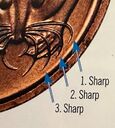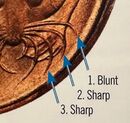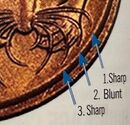Australian one-cent coin: Difference between revisions
No edit summary |
No edit summary |
||
| (21 intermediate revisions by the same user not shown) | |||
| Line 1: | Line 1: | ||
__FORCETOC__ | |||
=== Production === | |||
The initial 1966 issue was produced by three mints: 146.5 million coins at the Royal Australian Mint in Canberra, 239 million at the Melbourne Mint, and 26.6 million at the Perth Mint. Except for the years 1966 and 1981, all other one-cent coins were produced at the Canberra mint. In 1981, 40.3 million coins were minted at the British Royal Mint in Llantrisant, Wales, and 183.6 million in Canberra. The coin was not minted in 1986 and was last produced in 1990. | |||
The decision to withdraw the one-cent and two-cent coins was announced by the Treasurer in a Budget Speech on 21 August 1990. The coins were removed due to inflation reducing their value and the high cost of bronze. Around the same time, other countries also eliminated their bronze coins—New Zealand removed its one and two-cent coins in 1990, while the United Kingdom and Ireland transitioned their bronze one and two pence coins to copper-plated steel. | |||
{| class="wikitable" | {| class="wikitable" | ||
|+ | |+ | ||
| Line 8: | Line 12: | ||
!'''Composition''' | !'''Composition''' | ||
|- | |- | ||
|align="center"|0.01 AUD | |align="center"|$0.01 AUD | ||
|align="center"|2.60 g | |align="center"|2.60 g | ||
|align="center"|17.65 mm | |align="center"|17.65 mm | ||
| Line 17: | Line 21: | ||
!align="center"|'''Design''' | !align="center"|'''Design''' | ||
!align="center"|'''Designer''' | !align="center"|'''Designer''' | ||
!align="center"|'''Design date''' | ! colspan="2" align="center" |'''Design date''' | ||
|- | |- | ||
|align="center"|[[File:Australian 1c AM Coin.jpg|44px]] | |align="center"|[[File:Australian 1c AM Coin.jpg|44px]] | ||
|align="center"|Elizabeth II | |align="center"|Elizabeth II | ||
|align="center"|Arnold Machin | |align="center"|Arnold Machin | ||
| | | colspan="2" align="center" |1966 - 1994 | ||
|- | |- | ||
|align="center"|[[File:Australian 1c RM Coin.jpg|44px]] | |align="center"|[[File:Australian 1c RM Coin.jpg|44px]] | ||
|align="center"|Elizabeth II | |align="center"|Elizabeth II | ||
|align="center"|Raphael Maklouf | |align="center"|Raphael Maklouf | ||
| | | colspan="2" align="center" |1985 - 1990 | ||
|- | |- | ||
!align="center"|'''Reverse''' | !align="center"|'''Reverse''' | ||
!align="center"|'''Design''' | !align="center"|'''Design''' | ||
!align="center"|'''Designer''' | !align="center"|'''Designer''' | ||
!align="center"|'''Design date''' | ! colspan="2" align="center" |'''Design date''' | ||
|- | |- | ||
|align="center"|[[File:Australian 1c Coin.png|44px]] | |align="center"|[[File:Australian 1c Coin.png|44px]] | ||
|align="center"|Feathertail glider | |align="center"|Feathertail glider | ||
|align="center"|[[Stuart Devlin AO CMG|Stuart Devlin]] | |align="center"|[[Stuart Devlin AO CMG|Stuart Devlin]] | ||
| | | colspan="2" align="center" |1966 - 1990 | ||
|} | |} | ||
=== Mintage Figures === | |||
{|class="wikitable" | {|class="wikitable" | ||
|+ | |+ | ||
| Line 94: | Line 86: | ||
|RAM | |RAM | ||
|} | |} | ||
{|class="wikitable" | {|class="wikitable" | ||
|+ | |+ | ||
| Line 136: | Line 127: | ||
|RAM | |RAM | ||
|} | |} | ||
{|class="wikitable" | {|class="wikitable" | ||
|+ | |+ | ||
| Line 163: | Line 153: | ||
|+ | |+ | ||
: | : | ||
| colspan="4" |<small>RAM = Royal Australian Mint, RMM = Royal Melbourne Mint, RPM = Royal Perth Mint, RMLL = Royal Mint Llantrisant | | colspan="4" |<small>RAM = Royal Australian Mint, RMM = Royal Melbourne Mint, RPM = Royal Perth Mint, RMLL = Royal Mint Llantrisant</small> | ||
|} | |||
=== Mint Marks === | |||
Although there was no formal mint mark, the products of the Melbourne, Perth and Canberra mints can be identified by comparison of the whiskers on the feathertail glider left. The Melbourne coins have the first whisker (nearest the rim) blunted; Perth coins have the second whisker blunted while Canberra pieces show no blunting. | |||
There is no known difference between the Australian 1 cent coins produced by the two mints in 1981. The only information available is that the British Royal Mint in Llantrisant produced 40,300,000 coins, while the Royal Australian Mint (RAM) in Canberra produced 134,290,000 coins. | |||
When the 1 cent and 2 cent coins were withdrawn in 1991, they were returned to the mint. Eventually, they were melted down, and the metal was used to make the bronze medals for the 2000 Sydney Olympic Games. | |||
{| class="wikitable" | |||
|+ | |||
! align="center" |RAM (Canberra) | |||
! align="center" |RMM (Melbourne) | |||
! align="center" |RPM (Perth) | |||
|- | |||
| align="center" |[[File:MintMark1ccan.jpg|115px]] | |||
| align="center" |[[File:MintMark1cmel.jpg|130px]] | |||
| align="center" |[[File:MintMark1cper.jpg|130px]] | |||
|- | |||
|Canberra Mint: No blunted whiskers; all whiskers are sharp. | |||
|Melbourne Mint: The first whisker (nearest the rim) is blunted. | |||
|Perth Mint: The second whisker is blunted. | |||
|} | |} | ||
Latest revision as of 04:43, 25 June 2024
Production
The initial 1966 issue was produced by three mints: 146.5 million coins at the Royal Australian Mint in Canberra, 239 million at the Melbourne Mint, and 26.6 million at the Perth Mint. Except for the years 1966 and 1981, all other one-cent coins were produced at the Canberra mint. In 1981, 40.3 million coins were minted at the British Royal Mint in Llantrisant, Wales, and 183.6 million in Canberra. The coin was not minted in 1986 and was last produced in 1990.
The decision to withdraw the one-cent and two-cent coins was announced by the Treasurer in a Budget Speech on 21 August 1990. The coins were removed due to inflation reducing their value and the high cost of bronze. Around the same time, other countries also eliminated their bronze coins—New Zealand removed its one and two-cent coins in 1990, while the United Kingdom and Ireland transitioned their bronze one and two pence coins to copper-plated steel.
| Value | Mass | Diameter | Edge | Composition |
|---|---|---|---|---|
| $0.01 AUD | 2.60 g | 17.65 mm | Plain | 97% copper 2.5% zinc 0.5% tin |
| Obverse | Design | Designer | Design date | |
| Elizabeth II | Arnold Machin | 1966 - 1994 | ||
| Elizabeth II | Raphael Maklouf | 1985 - 1990 | ||
| Reverse | Design | Designer | Design date | |
| Feathertail glider | Stuart Devlin | 1966 - 1990 | ||
Mintage Figures
| Mintage year | 1966 | 1966 | 1966 | 1967 | 1968 | 1969 | 1970 | 1971 | 1972 | 1973 | 1974 |
|---|---|---|---|---|---|---|---|---|---|---|---|
| Mintage (Mil) | 146.5 | 239 | 26.6 | 110 | 19.9 | 87.7 | 72.6 | 102.5 | 82.4 | 140.7 | 131.7 |
| Mint | RAM | RMM | RMP | RMM | RMM | RAM | RAM | RAM | RAM | RAM | RAM |
| Mintage year | 1975 | 1976 | 1977 | 1978 | 1979 | 1980 | 1981 | 1981 | 1982 | 1983 | 1984 |
|---|---|---|---|---|---|---|---|---|---|---|---|
| Mintage (Mil) | 134.8 | 172.9 | 153.4 | 97.3 | 130.3 | 137.9 | 183.6 | 40.3 | 134.3 | 205.6 | 74.7 |
| Mint | RAM | RAM | RAM | RAM | RAM | RAM | RAM | RMLL | RAM | RAM | RAM |
| Mintage year | 1985 | 1987 | 1988 | 1989 | 1990 |
|---|---|---|---|---|---|
| Mintage (Mil) | 45.9 | 127 | 108.4 | 168.4 | 133.3 |
| Mint | RAM | RAM | RAM | RAM | RAM |
| RAM = Royal Australian Mint, RMM = Royal Melbourne Mint, RPM = Royal Perth Mint, RMLL = Royal Mint Llantrisant |
Mint Marks
Although there was no formal mint mark, the products of the Melbourne, Perth and Canberra mints can be identified by comparison of the whiskers on the feathertail glider left. The Melbourne coins have the first whisker (nearest the rim) blunted; Perth coins have the second whisker blunted while Canberra pieces show no blunting.
There is no known difference between the Australian 1 cent coins produced by the two mints in 1981. The only information available is that the British Royal Mint in Llantrisant produced 40,300,000 coins, while the Royal Australian Mint (RAM) in Canberra produced 134,290,000 coins.
When the 1 cent and 2 cent coins were withdrawn in 1991, they were returned to the mint. Eventually, they were melted down, and the metal was used to make the bronze medals for the 2000 Sydney Olympic Games.


